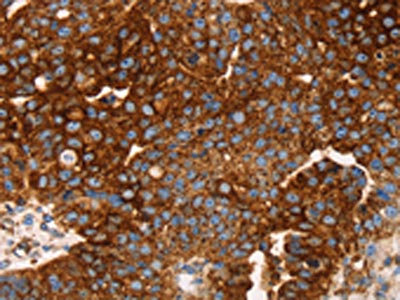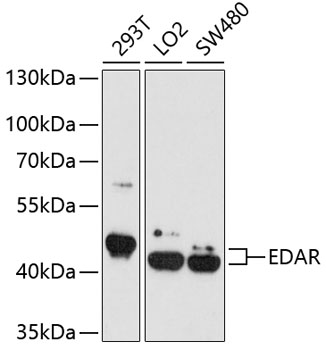
The image on the left is immunohistochemistry of paraffin-embedded Human breast cancer tissue using CSB-PA083210(EDAR Antibody) at dilution 1/45, on the right is treated with synthetic peptide. (Original magnification: x200)
EDAR Antibody
CSB-PA083210
ApplicationsWestern Blot, ELISA, ImmunoHistoChemistry
Product group Antibodies
ReactivityHuman, Mouse
TargetEDAR
Overview
- SupplierCusabio
- Product NameEDAR Antibody
- Delivery Days Customer20
- ApplicationsWestern Blot, ELISA, ImmunoHistoChemistry
- CertificationResearch Use Only
- ClonalityPolyclonal
- ConjugateUnconjugated
- Gene ID10913
- Target nameEDAR
- Target descriptionectodysplasin A receptor
- Target synonymsDL, ECTD10A, ECTD10B, ED1R, ED3, ED5, EDA-A1R, EDA1R, EDA3, HRM1, tumor necrosis factor receptor superfamily member EDAR, EDA-A1 receptor, anhidrotic ectodysplasin receptor 1, downless homolog, downless, mouse, homolog of, ectodermal dysplasia receptor, ectodysplasin 1, anhidrotic receptor, ectodysplasin A1 receptor, hypohidrotic ectodermal dysplasia
- HostRabbit
- IsotypeIgG
- Protein IDQ9UNE0
- Protein NameTumor necrosis factor receptor superfamily member EDAR
- Scientific DescriptionThis gene encodes a member of the tumor necrosis factor receptor family. The encoded transmembrane protein is a receptor for the soluble ligand ectodysplasin A, and can activate the nuclear factor-kappaB, JNK, and caspase-independent cell death pathways. It is required for the development of hair, teeth, and other ectodermal derivatives. Mutations in this gene result in autosomal dominant and recessive forms of hypohidrotic ectodermal dysplasia.
- ReactivityHuman, Mouse
- Storage Instruction-20°C or -80°C
- UNSPSC41116161





